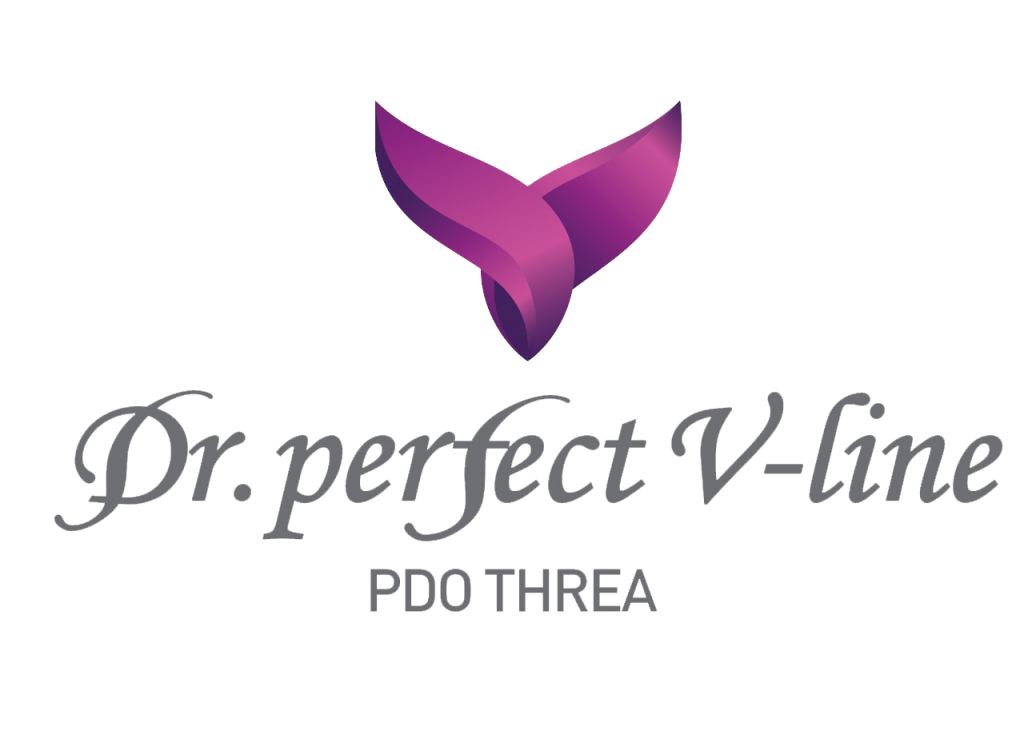
Lualuat Al Manama Est.
PDO THREADS FOR HAIR GROWTH
What are the
the Benefits of Threads Hair Growth ?


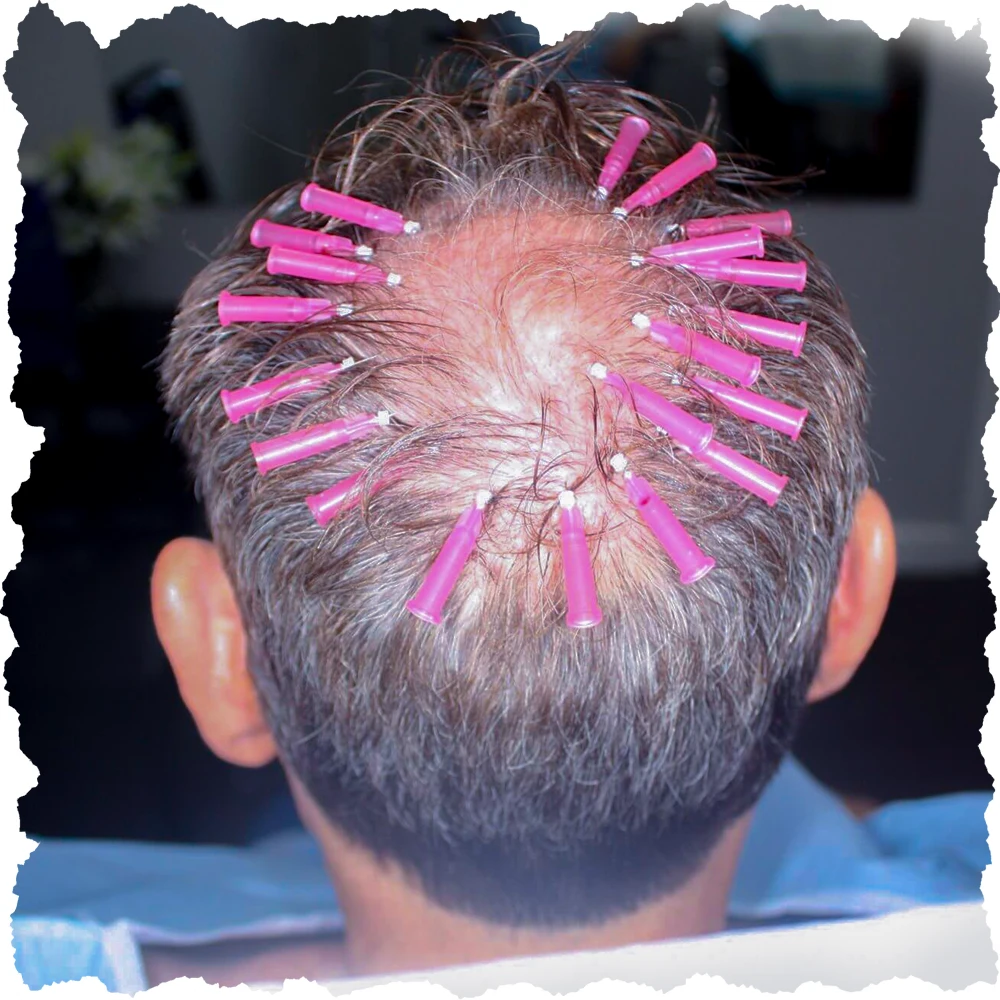

doi: 10.1080/09546634.2019.1682499. Epub 2020 Mar 3.
Monofilament threads in treatment of female hair loss
Mohamed Metwalli 1, Fathia M Khattab 1, Samira Mandour 2
Affiliations expand
- PMID: 31619089
- DOI: 10.1080/09546634.2019.1682499
Abstract
Background: Recently, thread treatment has been commonly used in Korean medicine for cosmetic reasons such as decreasing skin wrinkles. It was noted that an inserted thread caused constant stimulation, followed by assistance for connective tissue regeneration. However, its role in hair development has not yet been revealed.
Objective: To perform a pilot study on the effect of monofilament threads scalp injections in women with female androgenetic alopecia.
Materials and methods: This double-blind, multicenter, placebo-controlled study compared the effect of monofilament threads with that of saline as placebo. The endpoints were hair count and hair mass index (HMI), along with patient-opinion survey responses.
Results: HMI or hair count has statistically significantly differed between the study and placebo groups. However, 73.3% of the treatment subjects (vs. 0% of the placebo subjects) experienced substantial improvement in hair loss, rate of hair loss, hair thickness, and ease of managing/styling hair, and 76.8% (vs. 18.4% of the placebo group) reported that their hair felt coarser or heavier after the treatment.
Conclusion: Monofilament threads demonstrate highly statistically significant improvement in HMI or hair count in women female pattern hair loss. The patient survey results suggest a therapeutic advantage of monofilament threads as perceived by patients and according to hair count or HMI.
Dr.William Croly , MD / Director of AESTHETICS

Monofilament threads in treatment of female hair loss
Mohamed Metwalli,
Pages 521-525 | Received 20 Jul 2019, Accepted 15 Oct 2019, Accepted author version posted online: 17 Oct 2019, Published online: 03 Mar 2020
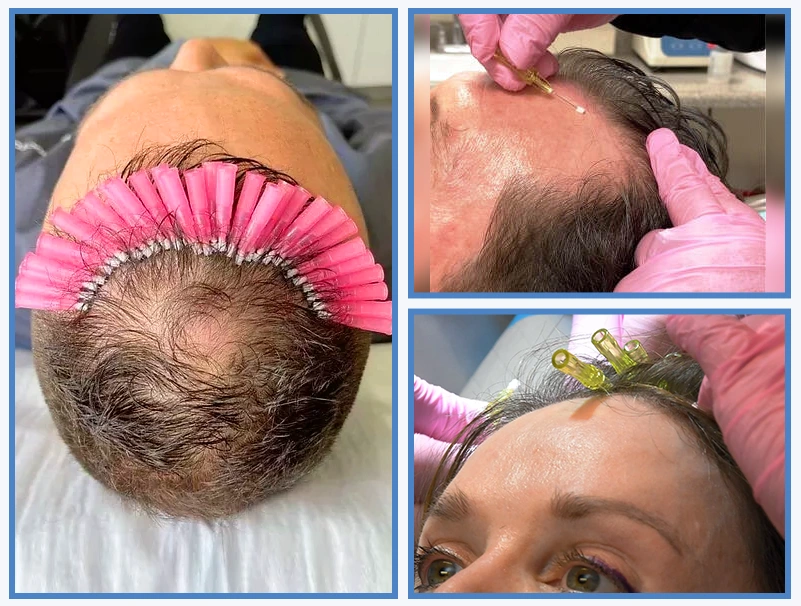

Threads Stimulate Hair Regrowth
July 28, 2020
Aesthetic Authority, Uncharted Territory: Aesthetic Authority Vol.1: No.2, Volume 1, Issue 2
Pages: 30
Hair restoration physician Dr. Alan Bauman says threads traditionally used in facial rejuvenation also are a safe, effective treatment option for some hair loss patients.
Using polydioxanone (PDO) threads is a relatively painless lunchtime procedure that can stimulate hair regrowth for six or more months in men and women with androgenetic alopecia.
Alan J. Bauman, M.D., who pioneered and trademarked the PDO thread insertion procedure PDOgro for hair regrowth in the U.S., has been performing the procedure for more than two years. He presented results from research on PDOgro and did a live interactive hair restoration session at the South Beach Symposium for Clinical and Aesthetic Dermatology in Miami, Fla., in 2019.
PDO is a slowly absorbing synthetic surgical suture material that stimulates collagen production, elastin, hyaluronic acid and new blood vessel formation. It also activates fibroblasts while it dissolves. FDA-cleared PDO sutures have been used safely in surgery for decades, according to Dr. Bauman.
“When you put PDO into the body as a deep suture, it lasts for more than six months. In the aesthetic world, they’ve been using these really thin, fine filaments of PDO very superficially in the skin to trigger tissue regeneration and repair,” Dr. Bauman says.
An aesthetic colleague asked Dr. Bauman if he had considered using these threads in the scalp, explaining that studies had shown that an unexpected result when using the threads for facial rejuvenation was a boost in hair growth in treated areas of hair-bearing skin.
In fact, there are studies suggesting the threads result in noticeable hair growth. Indian researchers evaluated the efficacy and safety of PDO thread insertion into the scalp in a small study of men with androgenic alopecia. They found that at 12 weeks, all five patients had appreciably increased hair counts, according to a letter to the editor published in 2015 in the Journal of the European Academy of Dermatology and Venereology.1
“Although the exact mechanism of action of hair growth stimulation by PDO threads remains speculative, it is likely to be similar to that of microneedling, involving enhanced expression of hair‐related genes, release of growth factors like PDGF and direct activation of stem cells in the hair bulge area,” the authors write.
Monofilament thread treatment also significantly improved hair mass index and hair counts in a study of women with female androgenetic alopecia, researchers reported in March 2020 in the Journal of Dermatological Treatment.2
Dr. Bauman says he initially performed the procedure on a small cohort of male and female patients with thinning or receding hair in 2018.
“We did it without any other therapy. These monotherapy patients were exclusively ‘virgin’ and had used no other treatments previously. We tried it in different areas. For example, one woman had thinning in the crown and another woman had a receding, thinning hairline and temple area,” Dr. Bauman says.
Every one of the first six patients treated some visual improvement within 6 to 12 weeks of the PDO thread insertion.
Dr. Bauman then rolled it out to patients who were interested in using PDO threads for hair growth either with or without other treatments. He has treated nearly 100 patients so far.
Dr. Bauman says he uses cross-sectional hair bundle trichometry (HairCheck) in several areas and global photos for tracking. In this cohort, Dr. Bauman has used primarily a combination of PDO threads with dual-spin platelet-rich plasma (PRP) to optimize results.
“We’ve seen nearly 90% improve or maintain their Hair Mass Index within six months of treatment and patient satisfaction has been excellent for this quick and comfortable ‘lunchtime’ treatment,” he says. “Recently, it has been a little difficult to track some of these patients through the shutdown to tell how long these results are lasting. Threads typically last in the body for 6 to 12 months. We imagine that it will be similar for the hair — about 6 to 12 months before we need to redo it.”
Ideal Thread Candidates
Patients need to have hair follicles for PDO threads to work.
“Just like with PRP, if there’s no follicle in the skin in that area, you’re not going to get a new follicle to reappear,” Dr. Bauman says. “It’s a good idea to do some measurements. Use your microscope and really get down and dirty to see how much vellus hair, terminal hair and miniaturized/intermediate hair density you have in each zone. Intermediate or miniaturized hair is likely what could be rejuvenated. If the area looks like it has been severely depleted, meaning the follicle density is shot, then the treatment probably isn’t going to do much except maybe protect what the patient has.”
Dr. Bauman says he has seen the most robust improvement in cases where he treated women and men with high numbers of weak (intermediate) hairs.
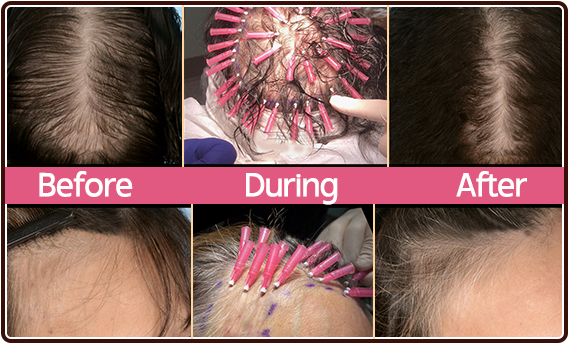

PDOgro: PDO Polydioxanone Threads for Hair Regrowth
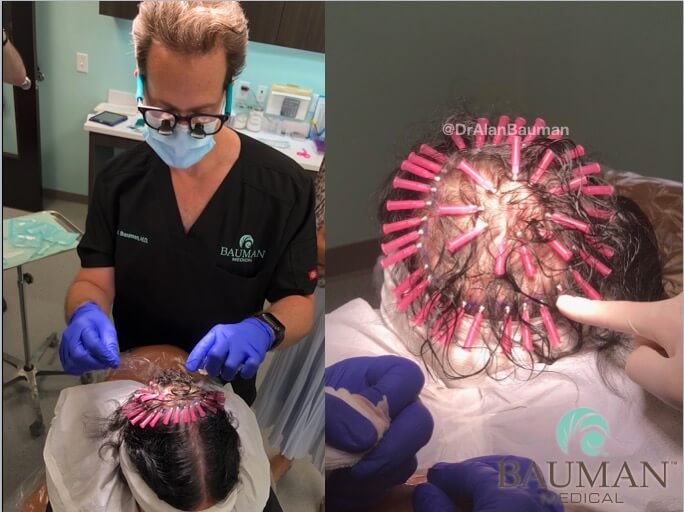
Posted on October 3rd, 2018
In this video, Dr. Alan J. Bauman explains why PDOgro is one of the best, new hair restoration treatments available today. Dr. Bauman explains what PDOgro is, how it works, who’s a candidate, what kind of results you can expect, and what it’s like to experience the PDOgro treatment.
Watch Dr. Bauman conduct the PDOgro procedure in this video:
PDOgro™ Polydioxanone Thread Procedure For Hair Regrowth
Hair Restoration Physician Dr. Alan J. Bauman is first to use PDO Polydioxanone Threads PDOgro™ Procedure for Hair Regrowth in the U.S.
PDOgro™ Procedure using Polydioxanone Threads for Hair Regrowth –
PDO is a known absorbable FDA-cleared synthetic suture and surgical scaffold material that stimulates endogenous collagen production, elastin, hyaluronic acid as well as activates fibroblasts. PDO (polydioxanone) threads have been used in aesthetic medicine for years for rejuvenation of skin, skin tightening, skin lifting, and wrinkle reduction. Hair regrowth in patients with hair loss from androgenetic alopecia has been observed in patients who had PDO threads inserted into their scalps. In this video you see ABHRS-certified hair restoration surgeon, Dr. Alan Bauman, performing the final step of his proprietary PDOgro™ process using MasterThreads in the thinning crown area of a hair loss patient “C.T.” Continued research will help determine how long the results of MasterThreads last and which candidates are likely to have the best hair regrowth effects. Non-surgical application of PDO threads into the scalp is a relatively safe and comfortable out-patient procedure with no downtime or aftercare. The PDOgro procedure using MasterThreads for hair regrowth may help prevent or reduce the need for hair transplantation. They may also be used for stopping, slowing, or reversing hair loss in conjunction with other treatments such as minoxidil, finasteride, low-level laser therapy, PRP platelet-rich plasma, and other cell therapy treatments. Dr. Bauman recommends that HairCheck hair regrowth measurements be performed every three months (90 days) to track the improvements in hair growth from treatment and to help determine when the next PDOgro thread treatment for hair regrowth is indicated.
PDOgro™ w/ MasterThreads: Before & After Results Photos
Clinical trials are now underway at Bauman Medical to determine how long the hair growth improvements with PDOgro threads will last as a stand-alone treatment, as well as with the addition of PRP at the time of insertion. In these patients below, the results were already beginning to become visible to the naked eye around 12 weeks (3 months). Female patient “M.M.” had PDOgro threads inserted at the hairline, right, and left temple area. Female patient “C.T.” had PDOgro threads inserted in the crown/vertex area. Male patient R.H. had PDOgro performed live by Dr. Alan Bauman at the prestigious South Beach Symposium for Aesthetic Dermatology in Miami in 2019. His results are seen at just three months post-treatment.
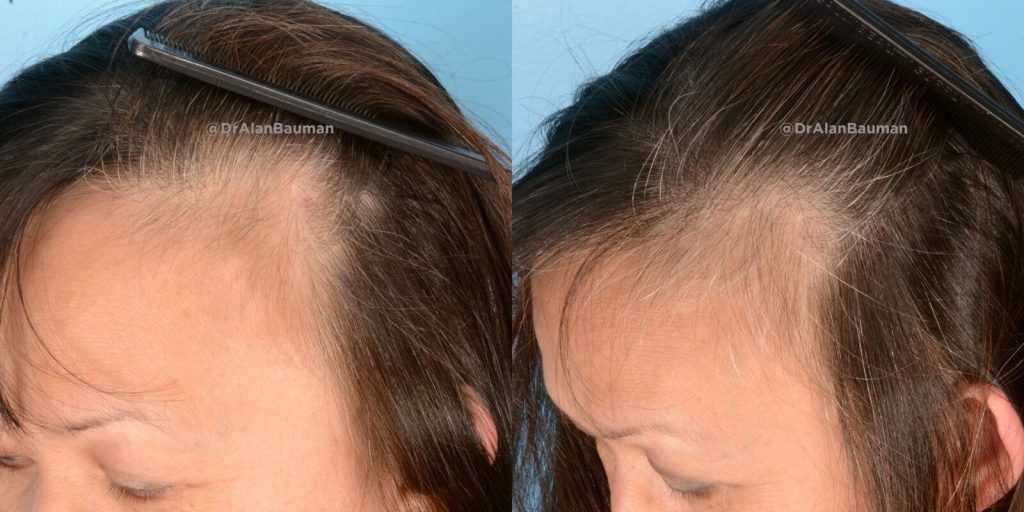
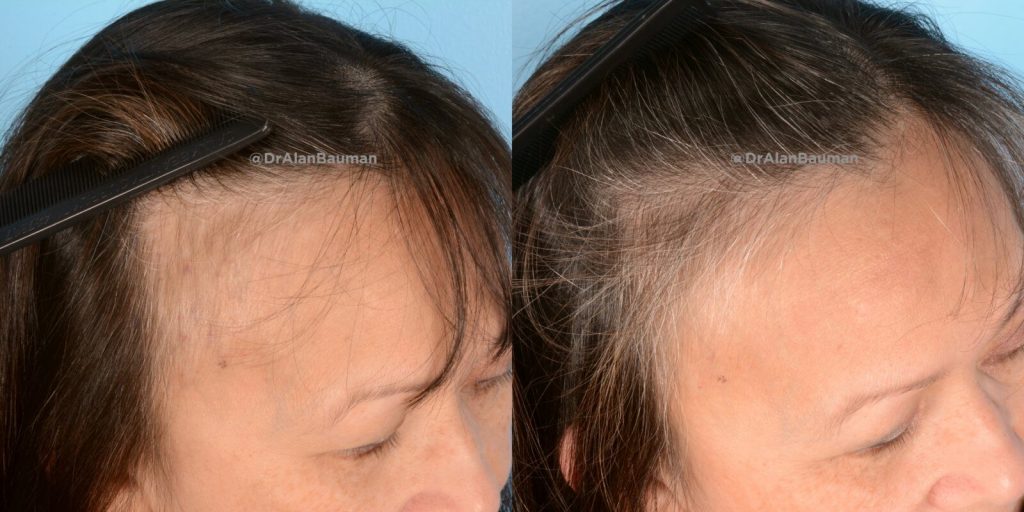
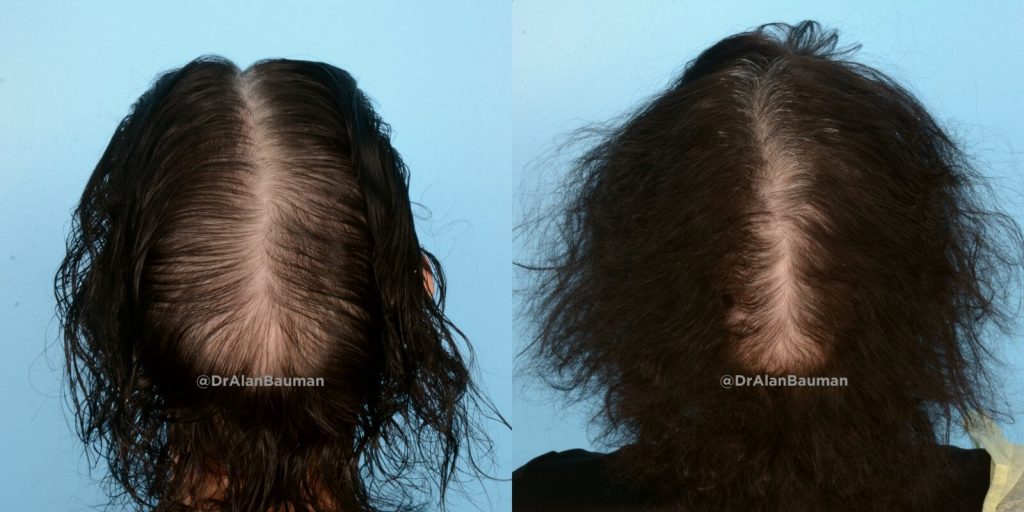
PDOgro™ for Male Pattern Hair Loss: Androgenetic Alopecia:
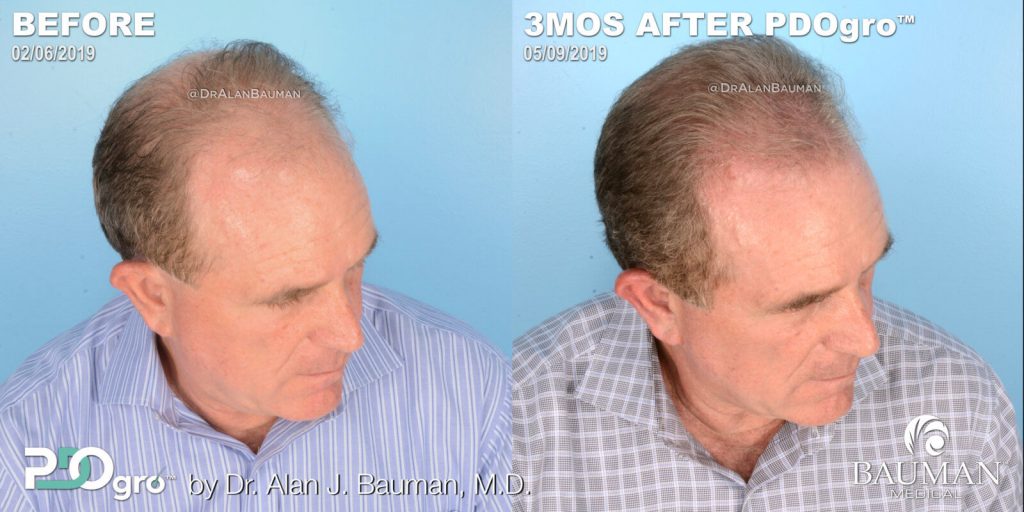
Before and 3 Months After PDOgro™ procedure by Dr. Alan Bauman for male pattern hair loss or androgenetic alopecia.
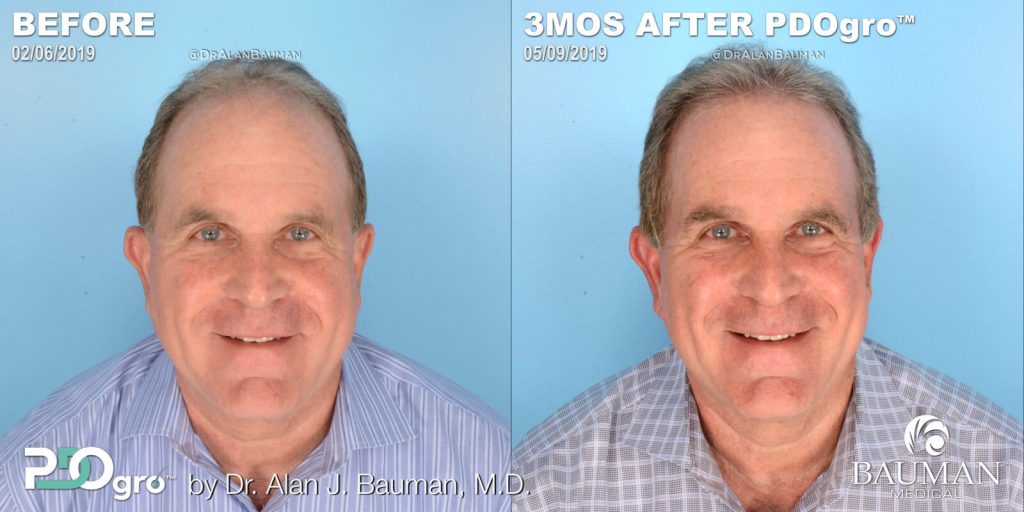
Before and 3 Months After PDOgro procedure by Dr. Alan Bauman for male pattern hair loss.